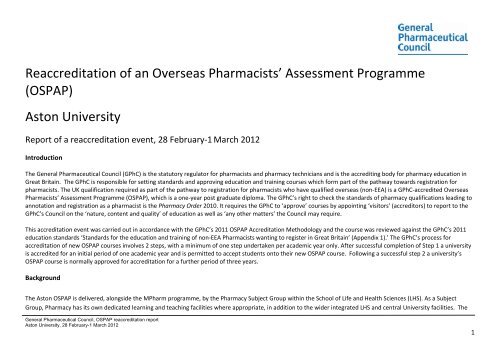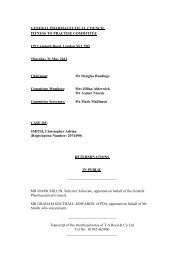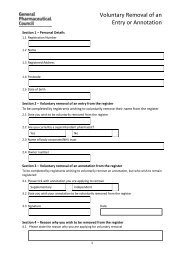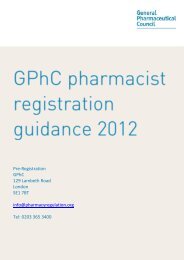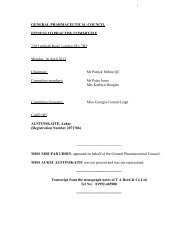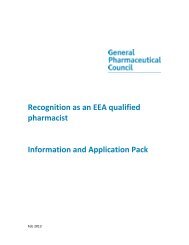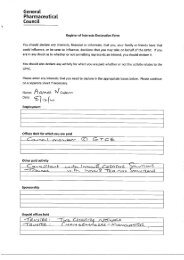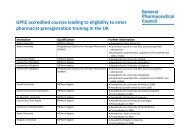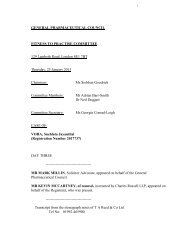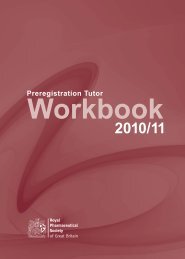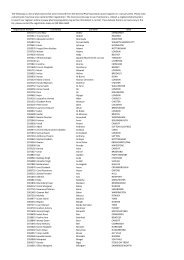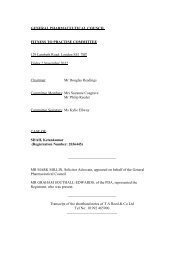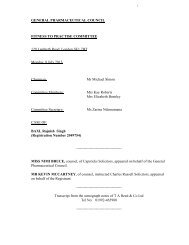(OSPAP) Aston University - General Pharmaceutical Council
(OSPAP) Aston University - General Pharmaceutical Council
(OSPAP) Aston University - General Pharmaceutical Council
You also want an ePaper? Increase the reach of your titles
YUMPU automatically turns print PDFs into web optimized ePapers that Google loves.
Reaccreditation of an Overseas Pharmacists’ Assessment Programme<br />
(<strong>OSPAP</strong>)<br />
<strong>Aston</strong> <strong>University</strong><br />
Report of a reaccreditation event, 28 February‐1 March 2012<br />
Introduction<br />
The <strong>General</strong> <strong>Pharmaceutical</strong> <strong>Council</strong> (GPhC) is the statutory regulator for pharmacists and pharmacy technicians and is the accrediting body for pharmacy education in<br />
Great Britain. The GPhC is responsible for setting standards and approving education and training courses which form part of the pathway towards registration for<br />
pharmacists. The UK qualification required as part of the pathway to registration for pharmacists who have qualified overseas (non‐EEA) is a GPhC‐accredited Overseas<br />
Pharmacists’ Assessment Programme (<strong>OSPAP</strong>), which is a one‐year post graduate diploma. The GPhC’s right to check the standards of pharmacy qualifications leading to<br />
annotation and registration as a pharmacist is the Pharmacy Order 2010. It requires the GPhC to ‘approve’ courses by appointing ‘visitors’ (accreditors) to report to the<br />
GPhC’s <strong>Council</strong> on the ‘nature, content and quality’ of education as well as ‘any other matters’ the <strong>Council</strong> may require.<br />
This accreditation event was carried out in accordance with the GPhC’s 2011 <strong>OSPAP</strong> Accreditation Methodology and the course was reviewed against the GPhC’s 2011<br />
education standards ‘Standards for the education and training of non‐EEA Pharmacists wanting to register in Great Britain’ (Appendix 1).’ The GPhC’s process for<br />
accreditation of new <strong>OSPAP</strong> courses involves 2 steps, with a minimum of one step undertaken per academic year only. After successful completion of Step 1 a university<br />
is accredited for an initial period of one academic year and is permitted to accept students onto their new <strong>OSPAP</strong> course. Following a successful step 2 a university’s<br />
<strong>OSPAP</strong> course is normally approved for accreditation for a further period of three years.<br />
Background<br />
The <strong>Aston</strong> <strong>OSPAP</strong> is delivered, alongside the MPharm programme, by the Pharmacy Subject Group within the School of Life and Health Sciences (LHS). As a Subject<br />
Group, Pharmacy has its own dedicated learning and teaching facilities where appropriate, in addition to the wider integrated LHS and central <strong>University</strong> facilities. The<br />
<strong>General</strong> <strong>Pharmaceutical</strong> <strong>Council</strong>, <strong>OSPAP</strong> reaccreditation report<br />
<strong>Aston</strong> <strong>University</strong>, 28 February-1 March 2012<br />
1
<strong>OSPAP</strong> commenced at <strong>Aston</strong> in October 2004 and was last reaccredited in 2008/9. That reaccreditation was conducted by the Royal <strong>Pharmaceutical</strong> Society of Great<br />
Britain (RPSGB) using the criteria then in operation. On that occasion, the accreditation team imposed no conditions but recommended that the School should revisit the<br />
syllabus to consider whether or not there was adequate coverage of a) drug and substance misuse b) Management of risk and c) product liability.<br />
Response to recommendations:<br />
a. Drug and substance misuse – this has been addressed in the Practical Therapeutics module. The students receive a lecture on drugs of abuse and misuse<br />
delivered by a consultant pharmacist from the drug addiction unit and a lecture on Supporting Addicts by a member of the SAFE Project team<br />
(http://www.safe.wmids.nhs.uk/about.asp).<br />
b. Management of risk‐ this has been addressed in the <strong>Pharmaceutical</strong> Technology module, in a series of lectures covering pharmaceutical quality, Quality control,<br />
Quality assurance, pharmaceutical validation, types of errors, sampling and customer and manufacturers risks.<br />
c. Product liability – this has also been introduced into the <strong>Pharmaceutical</strong> Technology module<br />
Documentation<br />
The provider submitted submission documentation to the GPhC in line with agreed timescales and a pre‐visit took place at <strong>Aston</strong> <strong>University</strong> on 20 th January 2012. During<br />
the pre‐visit the schedule of meetings and timings for the reaccreditation event were confirmed.<br />
The following documents were submitted by the university in advance of the event:<br />
• Completed GPhC submission template ‘Reaccreditation of an <strong>OSPAP</strong>’.<br />
• Programme specification, module specifications and course handbook<br />
• Staff profiles<br />
• A number of additional documents were provided as evidence to support each standard (listed at Appendix 2)<br />
The event<br />
The event began with a private meeting of the accreditation team and GPhC representatives on 28 February 2012. The remainder of the event took place on site at<br />
<strong>Aston</strong> <strong>University</strong> on 29 February‐1 March 2012, and comprised a series of meetings with staff and students of the <strong>University</strong> and included a tour of the <strong>University</strong><br />
facilities.<br />
<strong>General</strong> <strong>Pharmaceutical</strong> <strong>Council</strong>, <strong>OSPAP</strong> reaccreditation report<br />
<strong>Aston</strong> <strong>University</strong>, 28 February-1 March 2012<br />
2
Accreditation team<br />
The GPhC’s accreditation team (‘the team’) comprised:<br />
Name Designation at the time of accreditation event<br />
Mrs Linda Stone Accreditation team leader, (Pharmacy consultant, community pharmacy background)<br />
Professor Brenda Costall Accreditation team member (Professor of Neuropharmacology, former Head of School of Pharmacy, <strong>University</strong> of Bradford)<br />
Dr Brian Curwain Accreditation team member (Consultant to NHS organisations and the pharmaceutical industry and former PCT Chief Pharmacist;<br />
member of GPhC International Panel)<br />
Surinder Bassan Accreditation team member (Chief Pharmacist, Southampton <strong>University</strong> Hospitals; member of GPhC International Panel)<br />
Mrs Sylvia Hikins Accreditation team member (Lay Member, Management Consultant, Non‐Executive Director & Vice Chair for Mersey Regional<br />
Ambulance Service Trust)<br />
along with:<br />
Name Designation at the time of visit<br />
Ms Joanne Martin * Quality Assurance Manager (Education), GPhC<br />
Mrs Martha Pawlucyzk Registration and International Policy Manager, GPhC<br />
Professor Brian Furman Rapporteur (Emeritus Professor of Pharmacology, <strong>University</strong> of Strathclyde)<br />
*attended pre‐visit meeting on 28 October 2011.<br />
Declaration of potential conflicts of interest<br />
i. Surinder Bassan was involved in establishing a Diploma in Pharmacy Management at <strong>Aston</strong> <strong>University</strong> (1969‐72).<br />
ii. Linda Stone has acted as a pharmacy practice supervisor at <strong>Aston</strong> <strong>University</strong> (~1988‐93) and has also served as a member of a team established to set up a<br />
postgraduate diploma in community pharmacy.<br />
iii. Brian Furman has acted as a consultant to <strong>Aston</strong> <strong>University</strong> in relation to the establishment of a pharmacy‐unrelated overseas programme (October 2011).<br />
<strong>General</strong> <strong>Pharmaceutical</strong> <strong>Council</strong>, <strong>OSPAP</strong> reaccreditation report<br />
<strong>Aston</strong> <strong>University</strong>, 28 February-1 March 2012<br />
3
Meeting the accreditation standards<br />
Standard 1 – Patient and public<br />
safety<br />
There must be clear procedures to<br />
address concerns about patient safety<br />
arising from initial pharmacy education<br />
and training. Concerns must be<br />
addressed immediately.<br />
Standard 2 – Monitoring, review<br />
and evaluation of an <strong>OSPAP</strong><br />
The quality of pharmacy education and<br />
training must be monitored, reviewed<br />
and evaluated in a systematic and<br />
developmental way.<br />
Standard 3 – Equality, diversity and<br />
fairness<br />
<strong>OSPAP</strong>s must be based on principles of<br />
equality, diversity and fairness. It must<br />
meet the requirements of all relevant<br />
legislation.<br />
<strong>General</strong> <strong>Pharmaceutical</strong> <strong>Council</strong>, <strong>OSPAP</strong> reaccreditation report<br />
<strong>Aston</strong> <strong>University</strong>, 28 February-1 March 2012<br />
Accreditation team’s commentary<br />
The documentation provided abundant evidence that <strong>Aston</strong> has effective procedures in place to ensure that students do not<br />
jeopardise patient safety and only undertake tasks for which they are competent. Students are monitored and assessed to<br />
ensure that they always practise safely. The team was satisfied that the students have access to support for health, conduct<br />
and academic issues and understand what is and what is not professional behaviour, being familiar with the GPhC’s Code of<br />
Conduct for Pharmacy Students (2010) and Standards of Conduct, Ethics and Performance and <strong>Aston</strong>’s fitness to practise<br />
procedures. It was also clear to the team that the mechanisms for checking health and good character were sufficiently<br />
robust.<br />
The team was confident that the criteria to meet this standard will be met.<br />
The documentation described in detail <strong>Aston</strong>’s quality assurance mechanisms, including information about roles,<br />
responsibilities and lines of accountability within the Pharmacy Subject Group, the School of Life and Health Sciences and the<br />
<strong>University</strong>. The team was satisfied with the information provided on the <strong>OSPAP</strong> entry requirements, the quality of teaching,<br />
learning and assessment, the quality of placements, the appraisal and feedback systems for students, the supervision<br />
requirements and the educational resources and capacity for delivering the programme. There was ample evidence that all of<br />
these are monitored, reviewed and evaluated systematically.<br />
The team was confident that the criteria to meet this standard will be met.<br />
<strong>Aston</strong>’s commitment to equality and diversity was well articulated in the documentation and the <strong>University</strong> has a clear policy<br />
in this area, undertaking to promote equality and diversity within its community in all aspects of its work, including its<br />
admissions policies for students and its recruitment and selection processes for staff. Each member of the <strong>University</strong> must<br />
adhere to both the relevant legislation and <strong>University</strong> Policy in the treatment of other members of the <strong>University</strong> community.<br />
The <strong>University</strong> provides guidance for staff and students to enable them to fulfil this responsibility. Staff and students at all<br />
levels are required to treat one another with respect and courtesy. The <strong>University</strong> monitors progress and assesses the impact<br />
of relevant policies in promoting equality and diversity. The results of this monitoring and an annual equality report are<br />
published on the <strong>University</strong>’s Equality and Diversity web site. There is a comprehensive programme of equality training for all<br />
university staff. All new staff undertake this training as part of their induction process and, in the case of new academic staff,<br />
equality and diversity training are included in the postgraduate certificate of education, which all new staff must complete.<br />
The training of current staff in equality and diversity is monitored during their annual appraisals.<br />
4
Standard 4 – Selection of students<br />
Selection processes must be open, fair<br />
and comply with relevant legislation.<br />
Processes must ensure that students are<br />
fit to practise at the point of selection.<br />
Selection includes admissions.<br />
Standard 5 – Curriculum delivery<br />
and Student experience<br />
The curriculum for <strong>OSPAP</strong>s must deliver<br />
the outcomes in Standard 10. Most<br />
importantly, curricula must ensure that<br />
students practise safely and effectively.<br />
To ensure this, pass criteria must<br />
describe safe and effective practice.<br />
<strong>General</strong> <strong>Pharmaceutical</strong> <strong>Council</strong>, <strong>OSPAP</strong> reaccreditation report<br />
<strong>Aston</strong> <strong>University</strong>, 28 February-1 March 2012<br />
The team was confident that the two criteria to meet this standard will be met.<br />
The selection process appeared to be robust, being open, fair and compliant with relevant legislation; the selection criteria<br />
were transparent. Applicants must have been deemed eligible by the GPhC in terms of their overseas pharmacy qualification;<br />
the applicants must have achieved a certain level of English language proficiency, as evidence by a minimum score of 7 in the<br />
each component of the IELTS (International English Language Testing System) obtained at a single sitting and the <strong>University</strong><br />
undertook good character checks, in compliance with Standard 1. The <strong>University</strong> did not impose any requirements additional<br />
to those imposed by the GPhC in relation to the applicants’ first degree in pharmacy.<br />
The team was aware of a number of inaccuracies in the information provided to applicants via the website, the prospectus<br />
and the offer letter received by successful applicants. These had been notified to the School following the pre‐visit and the<br />
team confirmed with the <strong>Aston</strong> staff that these were being addressed.<br />
The team was confident that the three criteria to meet this standard will be met.<br />
The evidence provided in the documentation, together with extensive discussions with staff and students, demonstrated that<br />
the curriculum integrated both science and practice and was progressive, dealing with issues in an increasing complex way<br />
until the right level of understanding was reached. For example, while students initially dealt with patients with a single<br />
disease, later in the programme they addressed complex clinical problems, where patients may be suffering from multiple<br />
diseases. There are clear strategies for teaching, learning and assessment with the appropriate balance of theory and<br />
practical work, aimed at delivering and measuring the outcomes listed under standard 10; the programme encourages the<br />
students to become independent learners. The <strong>Aston</strong> <strong>OSPAP</strong> is delivered in an environment which places study in a<br />
professional and academic context, with many of the staff being pharmacists with both scientific and practice expertise.<br />
Many staff members are involved in the development of pharmacy policy at the local, national, and international level. The<br />
extensive engagement of practising pharmacists ensures that practical scenarios are used throughout the course in all<br />
modules in both lectures and workshops.<br />
The <strong>Aston</strong> <strong>OSPAP</strong> is informed by research and all academic staff are active researchers, with research examples used<br />
extensively in the teaching. Throughout the <strong>OSPAP</strong>, students must behave professionally and patient safety is clearly<br />
paramount in assessments, with any evidence of unsafe practice resulting in failure.<br />
The students undertook placements in hospital, visited a community pharmacy, undertook learning sessions with expert<br />
patients and received lectures from doctors, nurses, opticians and dieticians; however, their opportunities to work with, or<br />
learn alongside, other healthcare professionals was very limited. As this standard specifies that an <strong>OSPAP</strong> curriculum must<br />
include practical experience of working with patients, carers and other healthcare professionals, the team made a formal<br />
recommendation that the school should take further advantage of opportunities both within and external to the <strong>University</strong>,<br />
to provide this experience for the students (see ‘recommendation’).<br />
5
Standard 6 – Support and<br />
development for students<br />
Students must be supported to develop<br />
as learners and professionals during<br />
their <strong>OSPAP</strong><br />
Standard 7 – Support and<br />
development for academic staff<br />
Anyone delivering an <strong>OSPAP</strong> should be<br />
supported to develop in their<br />
professional roles.<br />
Standard 8 – Management of an<br />
<strong>OSPAP</strong><br />
An <strong>OSPAP</strong> must be planned and<br />
maintained through transparent<br />
processes which must show who is<br />
responsible for what.<br />
<strong>General</strong> <strong>Pharmaceutical</strong> <strong>Council</strong>, <strong>OSPAP</strong> reaccreditation report<br />
<strong>Aston</strong> <strong>University</strong>, 28 February-1 March 2012<br />
The team was confident that the twelve criteria to meet this standard will be met.<br />
The documentation, along with discussions with staff and students, provided evidence that there was a range of mechanisms<br />
in place to support students as learners and professionals during the <strong>OSPAP</strong>. Students are given a comprehensive induction<br />
at that commencement of the programme and introduced to the library, the support facilities and learning skills. They are<br />
introduced to continual professional development (CPD) and personal development planning (PDP) and are encouraged to<br />
reflect on their learning. The personal tutor system supports the students when needed and there is a comprehensive range<br />
of academic, pastoral and other support services available across the university.<br />
The team was confident that the one criterion to meet this standard will be met.<br />
There is a range of mechanisms in place to support staff development. <strong>Aston</strong> <strong>University</strong> has a formal appraisal process for all<br />
employees (the Performance Development and Reward Scheme), central to which is the annual Performance Development<br />
and Review (PDR) meeting. This meeting addresses key achievements and challenges during the previous period, progress<br />
against previous objectives and notable contributions to the success of the teaching team. It also addresses aims and<br />
objectives for the forthcoming review period, together with any resources needed to achieve them. There are many training<br />
opportunities to assist staff development in both teaching and research offered through the <strong>University</strong>’s Centre for Staff<br />
Development. These include induction and initial professional development support for newly appointed staff and a<br />
programme of events to meet training and development needs. The Centre for Staff Development also disseminates<br />
information on training and development opportunities, provides funds for training and updating to meet institutional<br />
priorities and legal requirements and works in partnership with individuals, groups, schools and departments to meet<br />
identified needs. All new staff within Pharmacy (including teacher practitioners) are expected to complete the <strong>Aston</strong><br />
Certificate in Learning and Teaching. In addition to the Performance Development and Reward Scheme, there is a mentoring<br />
system for all staff, which ensures that staff can discuss their personal development with someone not directly involved in<br />
making judgements about their performance.<br />
The team was confident that the three criteria to meet this standard will be met.<br />
The <strong>OSPAP</strong> is delivered within the School of Life and Health Sciences (LHS), led by the Executive Dean. The School Board is<br />
responsible for resources and for academic decisions within the school. Within the school, there is further separation of<br />
management function at subject level and each of the undergraduate subject areas (pharmacy, audiology, optometry,<br />
psychology, biology, biomedical sciences) has a Head of Subject, the Head of Pharmacy being Professor Yvonne Perrie. The<br />
Head of Pharmacy reports to the LHS senior management and is responsible for academic leadership, for representing<br />
pharmacy externally and for staff management, including work load allocation. The control of the pharmacy budget is<br />
devolved by the Executive Dean to the Head of Pharmacy.<br />
6
Standard 9‐ Resources and capacity<br />
Resources and capacity are sufficient to<br />
deliver outcomes.<br />
<strong>General</strong> <strong>Pharmaceutical</strong> <strong>Council</strong>, <strong>OSPAP</strong> reaccreditation report<br />
<strong>Aston</strong> <strong>University</strong>, 28 February-1 March 2012<br />
The Head of Pharmacy is supported by a Pharmacy Management Team, which includes senior staff representatives of the<br />
major teaching areas and the programme directors, including the <strong>OSPAP</strong> programme director.The Pharmacy Management<br />
Team oversees the management of the Pharmacy Subject Group, its facilities and academic programmes. The <strong>OSPAP</strong><br />
programme director is supported by an associate programme director and the module co‐ordinators, who are responsible for<br />
the day‐to‐day operation of their modules and are normally the primary contact point for students. They also have a key role<br />
in curriculum development.and are responsible for assessments within their modules, including exam preparation and<br />
collation and checking of examination marks.<br />
The <strong>OSPAP</strong> Programme Committee, which includes the module co‐ordinators, has overall responsibility for the development,<br />
design and review of the programme and serves as a forum for general discussion on key issues for the development and<br />
delivery of the programme. Accordingly, its principal roles are to review modules, address issues from external examiners’<br />
reports and from internal and external review bodies, to monitor learning facilities and resources, to consider and respond to<br />
student feedback and to monitor the quality of teaching and learning on the programme.<br />
The <strong>OSPAP</strong> is taught in its entirety from within the Pharmacy Subject Group, with appropriate use of visiting specialists and<br />
other professionals. The staff profile covers the breadth of experience and expertise across the relevant disciplines to deliver<br />
the Pharmacy programmes, including the <strong>OSPAP</strong> and about 50% of the staff are registered pharmacists.<br />
The team was confident that the one criterion to meet this standard will be met.<br />
There are robust and transparent mechanisms for securing an appropriate level of resource for delivering the <strong>OSPAP</strong>, as<br />
evidenced by the recent investment in pharmacy infrastructure and staff, which clearly benefits the <strong>OSPAP</strong> programme. The<br />
teaching facilities, including computer laboratories, are modern, spacious and well equipped. There is good library and<br />
information technology support for the <strong>OSPAP</strong> and there are sound mechanisms in place to maintain such support. <strong>Aston</strong><br />
<strong>University</strong> uses Blackboard as its virtual learning environment and <strong>OSPAP</strong> students make extensive use of this facility. The<br />
<strong>OSPAP</strong> programme, as well as the undergraduate pharmacy programme, benefit from the collaboration with Birmingham<br />
Children’s Hospital. This collaboration is aimed at supporting a two way exchange of staff between the two sites, to facilitate<br />
both new education and research Initiatives; the Deputy Chief Pharmacist at this hospital has a 50% appointment as a senior<br />
lecturer in the School of Life and Health Sciences.<br />
The pharmacy staff profile has been developed to support the integration of science within an embedded pharmacy<br />
education, such that all staff can contribute to the education and training of pharmacists; the profile covers the breadth of<br />
experience and expertise across the relevant disciplines to deliver the pharmacy programmes, including the <strong>OSPAP</strong>. During<br />
the appointment process, candidates must outline how their area of expertise contributes to pharmacy education. This<br />
ensures that all staff already have an implicit understanding of their role in the development of future pharmacists.<br />
Approximately 50% of staff in the pharmacy subject group, including the Head and Deputy Head and the <strong>OSPAP</strong> programme<br />
7
Standard 10 ‐ Outcomes<br />
Outcomes for non‐EEA pharmacists<br />
wanting to register in Great Britain<br />
<strong>General</strong> <strong>Pharmaceutical</strong> <strong>Council</strong>, <strong>OSPAP</strong> reaccreditation report<br />
<strong>Aston</strong> <strong>University</strong>, 28 February-1 March 2012<br />
director, are registered pharmacists. The <strong>OSPAP</strong> is supported by several pharmacists through their visiting and honorary<br />
positions. Within the <strong>OSPAP</strong> programme, all personal tutors are pharmacists, with each tutor having approximately 6 <strong>OSPAP</strong><br />
tutees. Thus, there are sufficient pharmacists to act as personal tutors, providing support and professional mentorship for<br />
the <strong>OSPAP</strong> students.<br />
All staff work within teaching groups, which comprise pharmacists and science academics. These teaching groups are led by<br />
pharmacists in collaboration with science academics, to ensure integration of science in a pharmaceutical context throughout<br />
the programme. This is then further developed through mentoring of all new staff and through working within a range of<br />
teams, including teaching groups and module teams under the supervision of the Programme Directors. The ability of staff<br />
within the Pharmacy Subject Group to contextualise their area is measured through student feedback and peer review, with<br />
a pharmacist reviewing a science academic and vice versa.<br />
Hospital pharmacy placements are planned and delivered by the teacher practitioner team. Placements in community<br />
pharmacy are co‐ordinated by a teaching fellow, supported by two teacher practitioners based in community pharmacy. The<br />
hospital and community teams work together to plan the overall provision of placement opportunities.<br />
The team was confident that the criteria to meet this standard will be met.<br />
The team scrutinised the standard10 learning outcomes (see Appendix 1) by discussions with the teaching staff in two<br />
parallel sessions comprising a ‘science’ session and a ‘practice’ session. Rather than examining each of the 58 outcomes in<br />
these sessions, a random selection of eight outcomes was chosen for detailed discussion. The outcomes chosen were 10.1h<br />
(‘Engage in multidisciplinary team working’), 10.2.1b (‘Access and critically evaluate evidence to support safe, rational & cost<br />
effective use of medicines’), 10.2.1g (‘Contribute to research and development activities to improve health outcomes’),<br />
10.2.2b (‘Identify inappropriate health behaviours and recommend suitable approaches to interventions’), 10.2.2j (‘Supply<br />
human and veterinary medicines safely and efficiently, consistently within legal requirements and best professional<br />
practice’), 10.2.3c (‘Verify safety and accuracy utilising pharmaceutical calculations’), 10.2.3f (‘Procure and store medicines<br />
and other pharmaceutical products working within a quality assurance framework’) and 10.2.4b (‘Obtain and record relevant<br />
patient medical, social and family history’). Additionally, before the event, the team had scrutinised all outcomes, using the<br />
documented evidence and some outcomes not discussed in these sessions were addressed in other discussions with staff and<br />
students. For each of the eight outcomes scrutinised in detail, the evidence provided by the discussions with the staff, along<br />
with other evidence provided with the documentation, gave the team confidence that these outcomes would be met at the<br />
required level. As these outcomes were selected at random, the team was confident that all other outcomes would be<br />
similarly met. This view was supported by the documented material for each of the other outcomes and the team was<br />
therefore confident that standard 10 will be met.<br />
8
Indicative Syllabus The team was content that the indicative syllabus was adequately covered by the <strong>Aston</strong> <strong>OSPAP</strong> curriculum.<br />
Summary and conclusions<br />
The accreditation team agreed to the Registrar of the <strong>General</strong> <strong>Pharmaceutical</strong> <strong>Council</strong> that <strong>Aston</strong> <strong>University</strong> should be reaccredited to provider an <strong>OSPAP</strong> for a further<br />
period of three years. No conditions were set.<br />
The accreditation team made the following recommendation:<br />
• The team recognise the input to the programme of a number of visiting lecturers from healthcare professions. However, the team recommends that the school<br />
take further advantage of inter‐professional learning opportunities both within and external to the <strong>University</strong>, to improve provision of inter‐professional learning<br />
in the <strong>OSPAP</strong> at <strong>Aston</strong>.<br />
The accreditation team identified a number of strengths and areas for further consideration. These were:<br />
Strengths:<br />
• The quality of the refurbished estate and resources<br />
Areas for further consideration:<br />
• To further develop the provision of quality assured practice activities<br />
The team’s recommendations are not binding on the Registrar, who may accept, modify or reject them. The accreditation team’s feedback is confidential until it has<br />
been ratified by the Registrar of the <strong>General</strong> <strong>Pharmaceutical</strong> <strong>Council</strong> but the conclusions may be shared with staff and students internally.<br />
The full record includes other comments from the team and the <strong>General</strong> <strong>Pharmaceutical</strong> <strong>Council</strong> regards the record in its entirety as its formal view on provision.<br />
Providers are required to take all comments into account as part of the accreditation process.<br />
Standing condition of accreditation:<br />
These are the conditions which will apply in all circumstances of <strong>OSPAP</strong> accreditation:<br />
1. The school or department of pharmacy always seeks approval from the <strong>General</strong> <strong>Pharmaceutical</strong> <strong>Council</strong> for curriculum amendments and always at least informs<br />
the <strong>General</strong> <strong>Pharmaceutical</strong> <strong>Council</strong> of significant changes to pharmacy undergraduate student numbers or resources for their teaching, learning support and<br />
assessment, including any change from internal to teaching, learning and assessment from outside the school or department;<br />
<strong>General</strong> <strong>Pharmaceutical</strong> <strong>Council</strong>, <strong>OSPAP</strong> reaccreditation report<br />
<strong>Aston</strong> <strong>University</strong>, 28 February-1 March 2012<br />
9
2. The school or department of pharmacy produces and submits to the <strong>General</strong> <strong>Pharmaceutical</strong> <strong>Council</strong> annually requested data on student numbers and<br />
progression and <strong>OSPAP</strong> awards;<br />
3. The school or department of pharmacy produces and submits to the <strong>General</strong> <strong>Pharmaceutical</strong> <strong>Council</strong> annually requested information about the extent of human<br />
and physical resources it enjoys for the delivery and support of the <strong>OSPAP</strong>;<br />
4. The school or department of pharmacy or the university makes students and potential students aware of the existence and Internet address where they can<br />
view the <strong>General</strong> <strong>Pharmaceutical</strong> <strong>Council</strong>’s summary reports of <strong>OSPAP</strong> accreditation exercises, main after‐actions therefrom and of the timetable for future<br />
accreditation exercises.<br />
The Pharmacy Order 2010 states:<br />
Part 5 Education, training and acquisition of experience and continuing professional development, Information to be given by institutions or other providers, 46. ...<br />
(3) Whenever required to do so by the <strong>Council</strong>, any institution or other provider to which this article applies must give to the <strong>Council</strong> such information and assistance as<br />
the <strong>Council</strong> may reasonably require in connection with the exercise of its functions under this Order.<br />
(4) Where an institution or other provider refuses any reasonable request for information made by the <strong>Council</strong> under this article, the <strong>Council</strong> may, in accordance with<br />
article 47 (‘Refusal or withdrawal of approval of courses, qualifications and institutions’), refuse to approve or withdraw approval from, any course of education or<br />
training, qualification, test or institution or other provider to which the information relates.<br />
It is a requirement of accreditation that institutions or other providers provide the GPhC proactively and in a timely manner with any information which is, or has the<br />
potential to be, material to the delivery of an accredited course. This includes, but is not limited to: changes in staffing, changes in funding, and/or substantial changes<br />
in curriculum or delivery.<br />
Reference: http://www.legislation.gov.uk/uksi/2010/231/contents/made<br />
Caution: Preregistration and employment as a pharmacist:<br />
• In respect of all students, successful completion of an accredited course in not a guarantee of a placement for a pre‐registration year or of future employment<br />
as a pharmacist.<br />
Following the above accreditation event, the Registrar of the <strong>General</strong> <strong>Pharmaceutical</strong> <strong>Council</strong> agreed with the accreditation team’s recommendation<br />
and approved the course for reaccreditation for a further three years.<br />
<strong>General</strong> <strong>Pharmaceutical</strong> <strong>Council</strong>, <strong>OSPAP</strong> reaccreditation report<br />
<strong>Aston</strong> <strong>University</strong>, 28 February-1 March 2012<br />
10
Appendix 1 ‐ Standards for the education and training of non‐EEA pharmacists wanting to register in Great Britain<br />
Standard 1 – Patient and public safety<br />
1. There must be clear procedures to address concerns about patient safety arising from pharmacy education and training. Concerns must be<br />
addressed immediately.<br />
1.1. There must be effective systems in place to ensure that students:<br />
1.1.a do not jeopardise patient safety;<br />
1.1.b only do tasks for which they are competent, sometimes under supervision;<br />
1.1.c are monitored and assessed to ensure they always practice safely. Causes for concern should be addressed immediately;<br />
1.1.d have access to support for health, conduct and academic issues;<br />
1.1.e must not be awarded an <strong>OSPAP</strong> if they might pose a risk to patients or the public;<br />
1.1.f understand what is and what is not professional behaviour and are familiar with the GPhC’s Code of Conduct for Pharmacy Students (2010)Standards of<br />
conduct, ethics and performance (2010);<br />
1.1.g understand what fitness to practise mechanisms apply to them. All schools of pharmacy must have fitness to practise procedures to deal with student<br />
causes for concern;<br />
1.1.h undergo required health and good character checks;<br />
1.1.i understand that it is an offence to impersonate a pharmacist. Pharmacists are registrants of the GPhC.<br />
<strong>General</strong> <strong>Pharmaceutical</strong> <strong>Council</strong>, <strong>OSPAP</strong> reaccreditation report<br />
<strong>Aston</strong> <strong>University</strong>, 28 February-1 March 2012<br />
11
Standard 2 – Monitoring, review and evaluation of an <strong>OSPAP</strong><br />
2. The quality of an <strong>OSPAP</strong> must be monitored, reviewed and evaluated in a systematic and developmental way.<br />
2.1 There must be systems and policies in place covering the following:<br />
2.1.a information about roles & responsibilities and lines of accountability;<br />
2.1.b university information on:<br />
i. entry requirements;<br />
ii. the quality of teaching, learning and assessment;<br />
iii. the quality of placements and other practice learning opportunities;<br />
iv. appraisal and feedback systems for students;<br />
v. supervision requirements;<br />
vi. educational resources and capacity;<br />
These must be monitored, reviewed and evaluated systematically. When an issue is identified it must be documented and dealt with promptly;<br />
Standard 3 – Equality, diversity and fairness<br />
3. <strong>OSPAP</strong>s must be based on principles of equality, diversity and fairness. It must meet the requirements of all relevant legislation.<br />
3.1 systems and policies for capturing equality and diversity data. Concerns should be documented, addressed and disseminated;<br />
3.2 strategies for staff training in equality and diversity<br />
<strong>General</strong> <strong>Pharmaceutical</strong> <strong>Council</strong>, <strong>OSPAP</strong> reaccreditation report<br />
<strong>Aston</strong> <strong>University</strong>, 28 February-1 March 2012<br />
12
Standard 4 – Selection of students<br />
4. Selection processes must be open, fair and comply with relevant legislation. Processes must ensure students are fit to practise as students at the<br />
point of selection. Selection includes admissions.<br />
4.1 Selection processes must give applicants the information they need to make an informed application.<br />
4.2 Selection criteria must be explicit. They should include:<br />
4.2.a meeting the GPhC’s adjudication requirements;<br />
4.2.b meeting academic and professional entry requirements;<br />
4.2.c meeting numeracy requirements;<br />
4.2.d recognising prior learning, where that is appropriate.<br />
4.3 Selectors should apply selection criteria fairly. They should be trained to do this. Training should include equality and diversity awareness.<br />
Standard 5 – Curriculum delivery and the student experience<br />
5. The curriculum for <strong>OSPAP</strong>s must deliver the outcomes in Standard 10. Most importantly, curricula must ensure students practise safely and<br />
effectively. To ensure this, pass criteria must describe safe and effective practice.<br />
5.1 Curricula must be integrated. By this the GPhC does not mean that an <strong>OSPAP</strong> and pre‐registration training must be delivered as single two tear course, but that the<br />
component parts of an <strong>OSPAP</strong> must be linked in a coherent way.<br />
5.2 Curricula must be progressive, dealing with issues in increasing more complex ways until the right level of understanding is reached.<br />
5.3 An <strong>OSPAP</strong> must be delivered in an environment which places study in a professional and academic context and requires students to conduct themselves<br />
professionally.<br />
5.4 An <strong>OSPAP</strong> must be delivered in an environment informed by research. This means that whether or not all staff are engaged in research, their teaching must be<br />
informed by current research.<br />
5.5 An <strong>OSPAP</strong> teaching and learning strategy must set out how students will achieve the outcomes in Standard 10. Learning opportunities must be structured to<br />
<strong>General</strong> <strong>Pharmaceutical</strong> <strong>Council</strong>, <strong>OSPAP</strong> reaccreditation report<br />
<strong>Aston</strong> <strong>University</strong>, 28 February-1 March 2012<br />
13
provide:<br />
5.5.a an integrated experience of relevant science and pharmacy practice;<br />
5.5.b a balance of theory and practice<br />
5.5.c independent learning skills<br />
5.6 The <strong>OSPAP</strong> curriculum must include practical experience of working with patients, carers and other healthcare professionals. We are not suggesting that off‐site<br />
placement visits are the only way to achieve this. Schools should articulate their strategy for meeting this criterion, which may include off‐site placement visits,<br />
using patients, carers and other healthcare professions in‐class and simulations.<br />
5.7 There must be a clear assessment strategy for the <strong>OSPAP</strong>. Assessment methods must measure the outcomes in Standard 10.<br />
5.8 The <strong>OSPAP</strong> assessment strategy should include:<br />
5.8.a diagnostic assessments;<br />
5.8.b formative assessments;<br />
5.8.c summative assessments;<br />
5.8.d timely feedback.<br />
5.9 Academic regulations must be appropriate for a postgraduate qualification that is both academic and professional and may lead to further professional training.<br />
As a general principle, all assessments must be passed. This means that condonation, compensation, trailing, extended re‐sit opportunities and other remedial<br />
measures should be extremely limited, if they are permitted at all. Course academic regulations may be more stringent than university norms. This may include<br />
higher than usual pass marks for assessments demonstrating knowledge and skills essential to safe and effective pharmacy practice.<br />
5.10 Marking criteria must be used for all assessments and all pass criteria must reflect safe and effective practice.<br />
5.11 Patient safety must be paramount in assessments: any evidence of an assessment demonstrating unsafe practise must result in failure.<br />
5.12 <strong>OSPAP</strong>s must include an induction programme orientating students to study in the UK. The programme should include diagnostic testing.<br />
Standard 6 – Support and development for students<br />
6. Students must be supported to develop as learners and professionals during their <strong>OSPAP</strong>s.<br />
6.1. A range of mechanisms must be in place to support students to develop as learners and professionals.<br />
<strong>General</strong> <strong>Pharmaceutical</strong> <strong>Council</strong>, <strong>OSPAP</strong> reaccreditation report<br />
<strong>Aston</strong> <strong>University</strong>, 28 February-1 March 2012<br />
14
Standard 7 – Support and development for academic staff<br />
7. Anyone delivering an <strong>OSPAP</strong> should be supported to develop in their professional roles.<br />
7.1. There must be a range of mechanisms in place to support anyone delivering an <strong>OSPAP</strong> to develop in their professional role.<br />
7.2. Induction programmes are provided for tutors and university staff as appropriate. This should include induction programmes for non‐pharmacists working on an<br />
<strong>OSPAP</strong>.<br />
7.3. Everyone involved in delivering the curriculum should have:<br />
7.3.a effective supervision;<br />
7.3.b an appropriate and realistic workload;<br />
7.3.c effective personal support;<br />
7.3.d mentoring;<br />
7.3.e time to learn;<br />
7.3.f continuing professional development opportunities.<br />
Standard 8 – Management of an <strong>OSPAP</strong><br />
8. An <strong>OSPAP</strong> must be planned and maintained through transparent processes which must show who is responsible for what.<br />
8.1. All <strong>OSPAP</strong>s must be supported by a defined management plan with:<br />
8.1.a a schedule of responsibilities;<br />
8.1.b defined structures and processes to manage the delivery of an <strong>OSPAP</strong>.<br />
<strong>General</strong> <strong>Pharmaceutical</strong> <strong>Council</strong>, <strong>OSPAP</strong> reaccreditation report<br />
<strong>Aston</strong> <strong>University</strong>, 28 February-1 March 2012<br />
15
Standard 9 – Resources and capacity<br />
9. Resources and capacity are sufficient to deliver outcomes.<br />
9.1 There must be:<br />
9.1.a robust and transparent mechanisms for securing an appropriate level of resource for delivering an <strong>OSPAP</strong>;<br />
9.1.b sufficient staff from relevant disciplines to deliver the curriculum to students. Staff must be appropriately qualified and experienced. The staffing profile<br />
must include:<br />
9.1.b.i sufficient numbers of pharmacists – registrants of the GPhC – with experience of teaching in higher education to ensure that an <strong>OSPAP</strong> can<br />
produce students equipped to enter pharmacist pre‐registration training in Great Britain.<br />
9.1.b.ii sufficient numbers of pharmacists to act as tutors and professional mentors at university and in pre‐registration. Not all personal tutors must<br />
be pharmacists.<br />
9.1.b.iii pharmacists who are leaders in the profession and in their university, who can influence university policy relevant to pharmacy<br />
9.1.b.iv non‐pharmacist academics who can influence school and university policy relevant to pharmacy<br />
9.1.b.v staff who are sufficiently experienced to supervise research. It would be unusual for anyone to supervise research at a particular level unless<br />
they had researched to that level or beyond. New research supervisors must be mentored and signed off as being fit to supervise after a<br />
period of mentoring<br />
9.1.b.vi science academics who understand the relevance of their discipline to pharmacy and deliver their area of expertise in a pharmaceutical<br />
context<br />
9.1.b.vii academic pharmacists and other experienced pharmacy staff who are able to act as mentors to non‐pharmacist colleagues<br />
9.1.c career pathways in universities for all staff teaching on <strong>OSPAP</strong>s, including pathways for practice staff;<br />
9.1.d clear lines of authority and responsibility for the strategic organisation and day‐to‐day management of placements;<br />
9.1.e training and ongoing support for all non‐pharmacists involved in the delivery of <strong>OSPAP</strong>s, which must help them understand:<br />
9.1.f.i help and understand the relevance of their work to pharmacy<br />
9.1.f.ii how to deliver their area of expertise in a pharmaceutical context<br />
9.1.f appropriate learning resources<br />
9.1.g accommodation and facilities that are fit for purpose<br />
<strong>General</strong> <strong>Pharmaceutical</strong> <strong>Council</strong>, <strong>OSPAP</strong> reaccreditation report<br />
<strong>Aston</strong> <strong>University</strong>, 28 February-1 March 2012<br />
16
Outcomes for non‐EEA pharmacists wanting to register in Great Britain<br />
10.1 Expectations of a pharmacy professional<br />
Note: Not all outcomes will be met on an <strong>OSPAP</strong>. In designing the course, providers make a judgement about which outcomes will have been met<br />
previously by their students, who will have trained to be pharmacists outside the EEA.<br />
Learning outcome<br />
<strong>OSPAP</strong> Pre‐reg<br />
(for reference<br />
only)<br />
a. Recognise ethical dilemmas & respond in accordance with relevant codes of conduct and behaviour Shows how Does<br />
b. Recognise the duty to take action if a colleague’s health, performance or conduct is putting patients or public at risk Knows how Knows how<br />
c. Recognise personal health needs, consult and follow the advice of a suitably qualified professional, and protect patients or public Does Does<br />
from any risk posed by personal health<br />
d. Apply the principles of clinical governance in practice Knows how Does<br />
e. Demonstrate how the science of pharmacy is applied in the design and development of medicines and devices Shows how Knows how<br />
f. Contribute to the education and training of other members of the team, including peer review and assessment Shows how Does<br />
g. Contribute to the development of other members of the team through coaching and feedback Knows how Shows how<br />
h. Engage in multidisciplinary team working Knows how Does<br />
10.2 The skills required in practice<br />
10.2.1 Implementing health policy<br />
Learning outcome<br />
<strong>General</strong> <strong>Pharmaceutical</strong> <strong>Council</strong>, <strong>OSPAP</strong> reaccreditation report<br />
<strong>Aston</strong> <strong>University</strong>, 28 February-1 March 2012<br />
<strong>OSPAP</strong> Pre‐reg<br />
a. Promote healthy lifestyles by facilitating access to and understanding of health promotion information Shows how Does<br />
b. Access & critically evaluate evidence to support safe, rational & cost effective use of medicines Shows how Does<br />
c. Use the evidence base to review current practice Shows how Shows how<br />
17
d. Apply knowledge of current pharmacy‐related policy to improve health outcomes Shows how Shows how<br />
e. Collaborate with patients, the public and other healthcare professionals to improve patient outcomes Knows how Does<br />
f. Play an active role with public and professional groups to promote improved health outcomes Knows how Knows how<br />
g. Contribute to research & development activities to improve health outcomes Knows how Knows how<br />
h. Provide evidence‐ based medicines information Shows how Does<br />
i. Respond appropriately to medical emergencies, including provision of first aid Knows how Shows how<br />
10.2.2 Validating therapeutic approaches and supplies prescribed and over‐the‐counter medicines<br />
Learning outcome<br />
<strong>General</strong> <strong>Pharmaceutical</strong> <strong>Council</strong>, <strong>OSPAP</strong> reaccreditation report<br />
<strong>Aston</strong> <strong>University</strong>, 28 February-1 March 2012<br />
<strong>OSPAP</strong> Pre‐reg<br />
a. Identify and employ the appropriate diagnostic or physiological testing techniques in order to promote health Knows how Shows how<br />
b. Identify inappropriate health behaviours and recommend suitable approaches to interventions Shows how Does<br />
c. Instruct patients in the safe and effective use of their medicines and devices Shows how Does<br />
d. Analyse prescriptions for validity and clarity Shows how Does<br />
e. Clinically evaluate the appropriateness of prescribed medicines Shows how Does<br />
f. Provide, monitor and modify prescribed treatment to maximise health outcomes Shows how Does<br />
g. Communicate with patients about their prescribed treatment Shows how Does<br />
h. Optimise treatment for individual patient needs in collaboration with the prescriber Shows how Does<br />
i. Record, maintain and store patient data Shows how Does<br />
j. Supply medicines safely and efficiently, consistently within legal requirements and best professional practice.<br />
NB This should be demonstrated in relation to both human and veterinary medicines.<br />
Shows how Does<br />
10.2.3 Ensuring safe and effective systems are in place to manage risk inherent in the practice of pharmacy and the delivery of pharmaceutical services<br />
Learning outcome<br />
<strong>OSPAP</strong> Pre‐reg<br />
a. Ensure quality of ingredients to produce medicines and products ‐ Shows how<br />
b. Apply pharmaceutical principles to the formulation, preparation and packaging of products Shows how Shows how<br />
c. Use pharmaceutical calculations to verify the safety of doses and administration rates Does Does<br />
d. Develop quality management systems including maintaining appropriate records Shows how Shows how<br />
18
e. Manage and maintain quality management systems including maintaining appropriate records<br />
<strong>General</strong> <strong>Pharmaceutical</strong> <strong>Council</strong>, <strong>OSPAP</strong> reaccreditation report<br />
<strong>Aston</strong> <strong>University</strong>, 28 February-1 March 2012<br />
Shows how Does<br />
f. Procure and store medicines and other pharmaceutical products working within a quality assurance framework Knows how Does<br />
g. Distribute medicines safely, legally and effectively Knows how Does<br />
h. Dispose of medicines safely, legally and effectively Knows how Does<br />
i. Manage resources in order to ensure work flow and minimise risk in the workplace Knows how Shows how<br />
j. Take personal responsibility for health and safety Knows how Does<br />
k. Work effectively within teams to ensure safe and effective systems are being followed Knows how Does<br />
l. Ensure the application of appropriate infection control measures Shows how Does<br />
m. Supervise others involved in service delivery Knows how Does<br />
n. Identify, report and prevent errors and unsafe practice Shows how Does<br />
o. Procure, store and dispense and supply veterinary medicines safely and legally Knows how Knows how<br />
10.2.4 Working with patients and the public<br />
Learning outcome<br />
<strong>OSPAP</strong> Pre‐reg<br />
a. Establish and maintain patient relationships while identifying patients’ desired health outcomes and priorities Shows how Does<br />
b. Obtain and record relevant patient medical, social and family history Shows how Does<br />
c. Identify and employ the appropriate diagnostic or physiological testing techniques to inform clinical decision making Knows how Shows how<br />
d. Communicate information about available options in a way which promotes understanding Shows how Does<br />
e. Support the patient in choosing an option by listening and responding to their concerns and respecting their decisions Shows how Does<br />
f. Conclude consultation to ensure a satisfactory outcome Shows how Does<br />
g. Maintain accurate and comprehensive consultation records Shows how Does<br />
h. Provide accurate written or oral information appropriate to the needs of patients, the public or other healthcare professionals Shows how Does<br />
10.2.5 Maintaining and improving professional performance<br />
Learning outcome<br />
<strong>OSPAP</strong> Pre‐reg<br />
19
a. Demonstrate the characteristics of a prospective professional pharmacist as set out in relevant codes of conduct and behaviour Does Does<br />
b. Reflect on personal and professional approaches to practice Does Does<br />
c. Create and implement a personal development plan Does Does<br />
d. Review and reflect on evidence to monitor performance and revise professional development plan Does Does<br />
e. Participate in audit and in implementing recommendations Knows how Shows how<br />
f. Contribute to identifying learning and development needs of team members Knows how Does<br />
g. Contribute to the development and support of individuals and teams Knows how Does<br />
h. Anticipate and lead change Knows how Shows how<br />
Indicative syllabus<br />
A1.1 How medicines work<br />
Therapeutics<br />
• Routes of administration<br />
• New therapeutic advances<br />
• Infection control<br />
• Complementary therapies<br />
• Clinical therapeutic uses of drugs<br />
Applied Physical, Chemical and Biological sciences<br />
• Sources and purification of medicinal substances<br />
• Physicochemical characteristics of drugs and biological systems<br />
• Thermodynamics and chemical kinetics<br />
• (Bio)Analytical principles and methods<br />
• Drug design and discovery<br />
• Cell and molecular biology<br />
• Biochemistry<br />
<strong>General</strong> <strong>Pharmaceutical</strong> <strong>Council</strong>, <strong>OSPAP</strong> reaccreditation report<br />
<strong>Aston</strong> <strong>University</strong>, 28 February-1 March 2012<br />
20
• Genetics<br />
• Microbiology<br />
• Immunology<br />
• <strong>Pharmaceutical</strong> chemistry<br />
• Drug identification<br />
• Drug synthesis<br />
Pharmacology, pharmacokinetics & pharmacodynamics<br />
• Contraindications, adverse reactions and drug interactions<br />
• ADME<br />
• Prediction of drug properties<br />
• Pharmacogenetics and pharmacogenomics<br />
• Drug and substance misuse<br />
• Clinical toxicology and drug‐over‐exposure<br />
• Molecular basis of drug action<br />
• Metabolism<br />
<strong>Pharmaceutical</strong> technology including manufacturing & engineering science<br />
• Biotechnology<br />
• Manufacturing methods<br />
• Quality assurance processes<br />
• Sterilisation and asepsis<br />
• Environmental control in manufacturing<br />
Formulation and material science<br />
• Materials used in formulations and devices<br />
• Biopharmaceutics, developmental pharmaceutics, pre‐formulation and formulation studies<br />
<strong>General</strong> <strong>Pharmaceutical</strong> <strong>Council</strong>, <strong>OSPAP</strong> reaccreditation report<br />
<strong>Aston</strong> <strong>University</strong>, 28 February-1 March 2012<br />
21
• Design and standardization of medicines<br />
• Microbiological contamination<br />
• Contamination control<br />
• Product stability<br />
• Medical devices<br />
A1.2 How people work<br />
Normal & abnormal structure & function<br />
• Nutrition<br />
• Physiology<br />
• Pathology<br />
• Infective processes<br />
Sociology<br />
• Social and behavioural science<br />
Health psychology<br />
• Health promotion<br />
• Disease prevention<br />
• Behavioural medicine<br />
Objective diagnosis<br />
• Differential diagnosis<br />
• Symptom recognition<br />
• Diagnostic tests<br />
Epidemiology<br />
• Aetiology and epidemiology of (major) diseases<br />
<strong>General</strong> <strong>Pharmaceutical</strong> <strong>Council</strong>, <strong>OSPAP</strong> reaccreditation report<br />
<strong>Aston</strong> <strong>University</strong>, 28 February-1 March 2012<br />
22
A1.3 How systems work<br />
Healthcare management<br />
• Public health<br />
• Organisations: NHS,DH, govt priorities<br />
• Other professionals<br />
• Health care systems<br />
Evidence‐based practice<br />
• Health information systems/ resources<br />
• Health policy and (pharmaco)economics<br />
Professional regulation<br />
• Legislation<br />
• Professional ethics and fitness to practise<br />
• Sale and supply of medicines<br />
• CPD<br />
• Political and legal framework<br />
Medicines regulation<br />
• Evaluation and regulation of new drugs and medicines<br />
• Pharmacopoeial specifications and biological standards<br />
• Medicines licensing<br />
• Product quality, safety and efficacy<br />
• The supply chain<br />
• Packaging, labelling and patient information<br />
Clinical governance<br />
<strong>General</strong> <strong>Pharmaceutical</strong> <strong>Council</strong>, <strong>OSPAP</strong> reaccreditation report<br />
<strong>Aston</strong> <strong>University</strong>, 28 February-1 March 2012<br />
23
• SOPs<br />
• Research methodology / research ethics<br />
• Risk & quality management<br />
• Good manufacturing/dispensing practice<br />
• Good clinical practice<br />
• Health policy, clinical and science research methods<br />
Clinical management<br />
• Disease management<br />
• Chronic medicines management<br />
• Medicines use review<br />
• Care planning<br />
Workplace Regulation<br />
• Health & Safety<br />
• Sexual boundaries<br />
• Independent Safeguarding Authority<br />
• Data protection<br />
• FOIA<br />
• Consumer protection incl. complaints procedures<br />
A1.4 Core and transferable skills<br />
Professionalism<br />
Research and research methods<br />
Critical appraisal<br />
• Audit and learning from errors<br />
Problem solving<br />
• Study skills<br />
<strong>General</strong> <strong>Pharmaceutical</strong> <strong>Council</strong>, <strong>OSPAP</strong> reaccreditation report<br />
<strong>Aston</strong> <strong>University</strong>, 28 February-1 March 2012<br />
24
• Team‐working skills<br />
Clinical decision making<br />
• Leadership skills<br />
Accurate record keeping<br />
Reflective practice (incl. continuing professional development)<br />
Effective communication<br />
• Interpersonal skills<br />
• Medical terminology<br />
Interpret & interrogate clinical data<br />
Analyse & use numerical data<br />
<strong>Pharmaceutical</strong> numeracy<br />
Technological literacy<br />
A1.5 Attitudes and values<br />
See the GPhC Code of Conduct for pharmacy students (2010) and Standards of conduct, ethics and performance (2010)<br />
<strong>General</strong> <strong>Pharmaceutical</strong> <strong>Council</strong>, <strong>OSPAP</strong> reaccreditation report<br />
<strong>Aston</strong> <strong>University</strong>, 28 February-1 March 2012<br />
25
Appendix 2 – list of appendices provided as evidence for each standard<br />
Appendix 1 Appendix 5<br />
1.1 – <strong>University</strong> Fitness to Practise Regulations. 5.1 – <strong>OSPAP</strong> Programme Specification 2011‐2012<br />
1.2 – <strong>University</strong> Student Disciplinary Regulations 5.2 – <strong>OSPAP</strong> Module Specifications<br />
1.3 – Summary of <strong>OSPAP</strong> Fitness to Practise Referral Pathways 5.3 – Professional visit form<br />
1.4 – Student Code of Conduct 5.4 – LHS research Groups and Membership<br />
1.5 – <strong>OSPAP</strong> Fitness to Practise forms 5.5 – <strong>OSPAP</strong> Teaching and Learning Strategy<br />
1.6 – PHMPP3 Module Specification Appendix 6<br />
1.7 – PHMSK1 Community Pharmacy Visit Introductory slides 6.1 – CPD plans<br />
1.8 – <strong>OSPAP</strong> External Community Teaching Workbook 2011 2012 6.2 – PDP plans<br />
1.9 – Pharmacy Fitness to Practise Report 2010‐2011 6.3 – <strong>OSPAP</strong> Pre Registration Information 2011‐2012<br />
2.1 – Module Reflections Forms 2010‐2011 6.4 – Email template for new <strong>OSPAP</strong> student<br />
Appendix 2 Appendix 7<br />
2.2 – Action plans, external reports and responses 7.1 – Performance Development review information<br />
2.3 – LHS PG Annual Monitoring Reports 7.2 – PDR reward scheme<br />
2.4 – Previous Internal Review Document 7.3 – Guidelines for PDR meeting<br />
2.5 – <strong>University</strong> Learning and Teaching Committee 7.4 – PDR overview<br />
2.6 – <strong>OSPAP</strong> Programme Committee Minutes 7.5 – PDR questions<br />
2.7 – LHS Learning and Teaching Committee 7.6 – PDR Forms<br />
2.8 – Job Descriptions – LHS and <strong>OSPAP</strong> 7.7 – <strong>Aston</strong> Certificate<br />
2.9 – Pre‐registration Pass Rates 7.8 – Example of staff development information<br />
2.10 – Postgraduate Student Satisfaction Survey 7.9 – ILM evidence<br />
2.11 – Staff Student Consultative Committee minutes 7.10 – Leadership & management qualifications framework<br />
2.12 – End of Year Evaluation 7.11 – Mentoring for staff information<br />
2.13 – <strong>OSPAP</strong> Practice Placements 7.12 – <strong>University</strong> staff development policy<br />
2.14 ‐ Chief Pharmacist Meetings 7.13 – Example of online support for staff (Equality and Diversity)<br />
2.15 – Placement Monitoring 7.14 – Example information available on LHS staff VLE<br />
2.16 – Policy on Student Feedback 7.15 – LHS Management structure<br />
2.17 – ICT User Group Terms of Reference Appendix 8<br />
Appendix 3 8.1 – School Management structure<br />
3.1 – Equality & Diversity Monitoring 8.2 – School Board Membership and TOR<br />
3.2 – Age Code of Practice 8.3 – School Board example agenda<br />
3.3 – Staff Disability Policy 8.4 – School Board example minutes<br />
<strong>General</strong> <strong>Pharmaceutical</strong> <strong>Council</strong>, <strong>OSPAP</strong> reaccreditation report<br />
<strong>Aston</strong> <strong>University</strong>, 28 February-1 March 2012<br />
26
3.4 – Disability Equality scheme 8.5 – School Senior Management Team (SMT)<br />
3.5 – Race and Equality Scheme 8.6 – SMT example Agenda<br />
3.6 – Gender Equality Scheme 8.7 – SMT example Minutes<br />
3.7 – Religion & Belief Code 8.8 – Pharmacy Management Team example notes<br />
3.8 – Sexual orientation code 8.9 – Pharmacy Subject Group Agenda<br />
3.9 – Prevention of Harassment 8.10 – Pharmacy Subject Group minutes<br />
3.10 – Domestic Violence Policy 8.11 – Programme Specification<br />
3.11 – Gender, Progress, Power 8.12 – Student Handbook<br />
3.12 – crossing boundaries 8.13 ‐ Summary of SLAs<br />
3.13 – Intercultural Competency Framework 8.14 – Example SLA Hospital<br />
3.14 – student complaints Procedure 8.15 – Example of community pharmacy agreement<br />
3.15 – Examples Equality & diversity report and Action plan 8.16 – SLA senior lecturer appointment<br />
Appendix 4 Appendix 9<br />
4.1 – Web Application Information 9.1 – Summary Pharmacy Income and Expenditure<br />
4.2 – Postgraduate Prospectus 9.2 – <strong>Aston</strong> Pharmacy school staff profiles<br />
4.3 – Offer Letter to an <strong>OSPAP</strong> Applicant 9.3 – Summary of Pharmacy staff teaching qualifications<br />
4.4 – Information about Future registration 9.4 – Example of peer review<br />
4.1 – Web Application Information 9.5 ‐ Accommodation for pharmacy<br />
Appendix 10<br />
10.1 – Standards Map<br />
<strong>General</strong> <strong>Pharmaceutical</strong> <strong>Council</strong>, <strong>OSPAP</strong> reaccreditation report<br />
<strong>Aston</strong> <strong>University</strong>, 28 February-1 March 2012<br />
27


